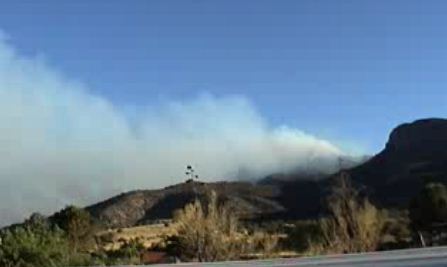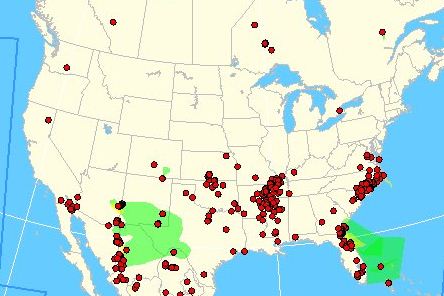Update: on June 21 we posted more information about the Monument fire, including a current map.
========================
Update: on June 16 we posted an updated article about the Monument fire.
=========================
Update at 7:33 MT, 6-15-2011:
Teresa Jun, a reporter for KOLD, said via Twitter about 20 minutes ago that she is at a public meeting and was told the fire has burned 9,300 acres. She said about 1,000 people were packed into the meeting room in Sierra Vista to hear about the fire. Strong winds are forecast for Thursday.
Added a time-lapse video.
Right now, a live streaming web cam is showing the fire.

=========================
Still another fire in Arizona has developed into a serious, destructive incident. The Monument fire eight miles south of Sierra Vista started on June 12 and has blackened over 5,000 acres, burned or damaged 40 homes, and crossed the international border from Arizona into Mexico.
Scroll down to see maps of the Monument fire, but here is information from the Cochise County Sheriff’s Office, at 5:16 p.m., June 15:
Structure Damage/Loss:
50 structures (40 homes and 10 other structures) determined as of this time, damaged or lost in the Ash Canyon area including the listed roads: Ash Canyon Road, Muffin Lane, Deer Trail, Prince Placer, Acorn, Pickett Lane, Twin Oaks, Mountainview, Stoneridge, Turkey Track and East Spring Road. Additional assessments will be completed throughout the day.
Closures/Evacuations:
Ash Canyon, Hunter Canyon, Stump Canyon (both upper and lower), Turkey Track will remain closed until further notice.
Mandatory Evacuations:
West of Highway 92: Hereford Road to Ash Canyon Road. This includes East Flying V Lane East Miller Canyon Road, East Hillcrest Drive, East Bristlecone Lane, East Oak Haven, East Hunter Canyon, East Baumkirchner Road, East Stump Canyon Road, East Spring Road and South Deer Trail.
West of Highway 92: Hereford Road to S. Circle Drive and South to East Pioneer Lane to include Cave Place, Haul Drive, Davis Street, Shirley Drive, East Corral Drive, Madelein Drive, East Bricky Drive, East Roger Drive, East Linda Vista Drive, Olive Lane, Calle Coyote, East Antler Trail, La Paloma, Sunnyvale Road, Valley Vista and Pioneer Place.
People are encouraged to leave immediately.
Here is a link to a map that shows all of the large wildfires in the United States.
Maps and a time-lapse video of the Monument fire are below:
Continue reading “Monument fire in Arizona burns or damages 40 homes”







